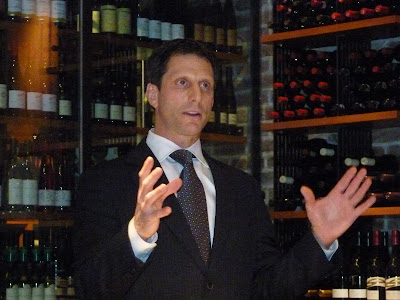Photo: Ray Signorello Jr., Vancouver's Napa winemaker
In 1983, when winemaker Ray Signorello Jr. was 20, his
father took him to Europe . It was an
experience that shaped his career in wine.
In particular, there was a dinner at a fine Paris
restaurant where they shared a 1945 claret from a good Bordeaux
estate; clearly, Ray Signorello Sr. knew that 1945 was Bordeaux ’s vintage of the century. In fact,
he was so impressed that he paid $50 a bottle for the entire restaurant stock
of that wine, some three cases, and had it shipped back to North
America for subsequent enjoyment by the Signorello family.
These days, the family does not need to go nearly so far for
fine wine. Signorello Estate Winery on the Silverado Trail in Napa produces truly first-rate Cabernet Sauvignon
and Chardonnay. The flagship wine is a Cabernet Sauvignon called Padrone
(Italian for patron or boss). The name was chosen in tribute to the elder
Signorello, who died in 1998.
Padrone is a very limited production wine, ranging from a
low of 125 cases to a high of 650 cases, depending on the vintage. It sells for
$170 a bottle in British Columbia .
Ordinarily, a collectible Napa Cabernet like this might
hardly ever be offered in British
Columbia . Fortunately for wine collectors in British Columbia , the Signorello family moved to West Vancouver shortly after Ray Jr. was born in San Francisco in 1963.
Even after developing a winery in Napa ,
the family never moved back.
Numerous Vancouver charities
thank their good fortune that Ray Jr. lives in West Vancouver . They often hit him up for
wine and, often, he comes through. During the recent Vancouver International
Wine Festival, he provided some of the wine for the Gala dinner and he hosted
vertical tasting of 10 vintages of Padrone. The tasting spanned vintages from
1997, the first, to 2009, which is about to be listed in British Columbia .
It even included the 2003 vintage, the rarest of all Padrone
vintages because Signorello Estate Winery was among 95 California wineries that
once stored their wines in a facility called Wine Central, a former submarine
repair base. In the fall of 2005, an arson fire destroyed $250 million worth of
wine including 15,000 cases of Signorello wines. Four cases of Padrone survived
because they had remained at the winery. Since then, Signorello has built its
own storage. The arsonist, who was trying to cover up a wine version of a Ponzi
scheme, got a 27-year jail term last February.
It says a lot about Ray Jr.’s generosity that he would even
include the 2003 Padrone in the tasting. Indeed, the winery does not make
Padrone in every vintage, only in the best years, so there will always be gaps
in verticals. “We make as little Padrone, or as much, as the quality allows,”
Ray. Jr. says.
The Signorello family got into the wine business because, in
the 1970s, Ray Sr. bought 100 acres on Silverado Trail – a very good Napa address – and
planted an assortment of varietals. Initially, the intent was to sell the
grapes, since Ray Sr. was fully involved in other business ventures in Vancouver .
The grape crop was so bounteous in 1985 that the Signorello
family had to start making wine. A winery was built the following year.
In 1990, by which time Ray Jr. was fully engaged in the wine
business, they rationalized the vineyard, planting primarily the red Bordeaux varieties. They
were fortunate in their timing. Vines that had been planted in the 1970s and
1980a in Napa
were found to have been planted on roots that were not resistant to phylloxera.
By 1990, the industry was using rootstock that is resistant to phylloxera.
Those who find Padrone out of reach have other options for
tasting Signorello-made Cabernet Sauvignon. The winery’s Napa Estate Cabernet
Sauvignon is listed in British
Columbia at about $100 a bottle. As well, Edge
Winery, which Ray Jr. helped start in 2001, has a $30 Cabernet Sauvignon in the
British Columbia
market.
In most vintages, Padrone has been a blend of 75% to 89%
Cabernet Sauvignon, with small percentages of Merlot and Cabernet Franc
completing the blends. Recently, Signorello has decided to drop Merlot from the
blend. “It is not that it is bad,” he says. “It is just not adding anything to
the blend.” Cabernet Franc, on the other hand, stays in the wine in top years.
However, the 2009
Padrone, soon to arrive in British
Columbia , is 100% Cabernet Sauvignon. It was also one
of my favourite wines at the tasting – and believe me, it was tough pick
favourites. This is a bold wine, with aromas of spice, blackberry, cherry and
vanilla exploding dramatically from the glass. Rich in texture, the wine
delivers all those flavours along with red liquorice and spice on the finish. I
expect it will peak about 2019 and then hold for many years. 95.

1 comment:
well written article John - great backstory
Post a Comment